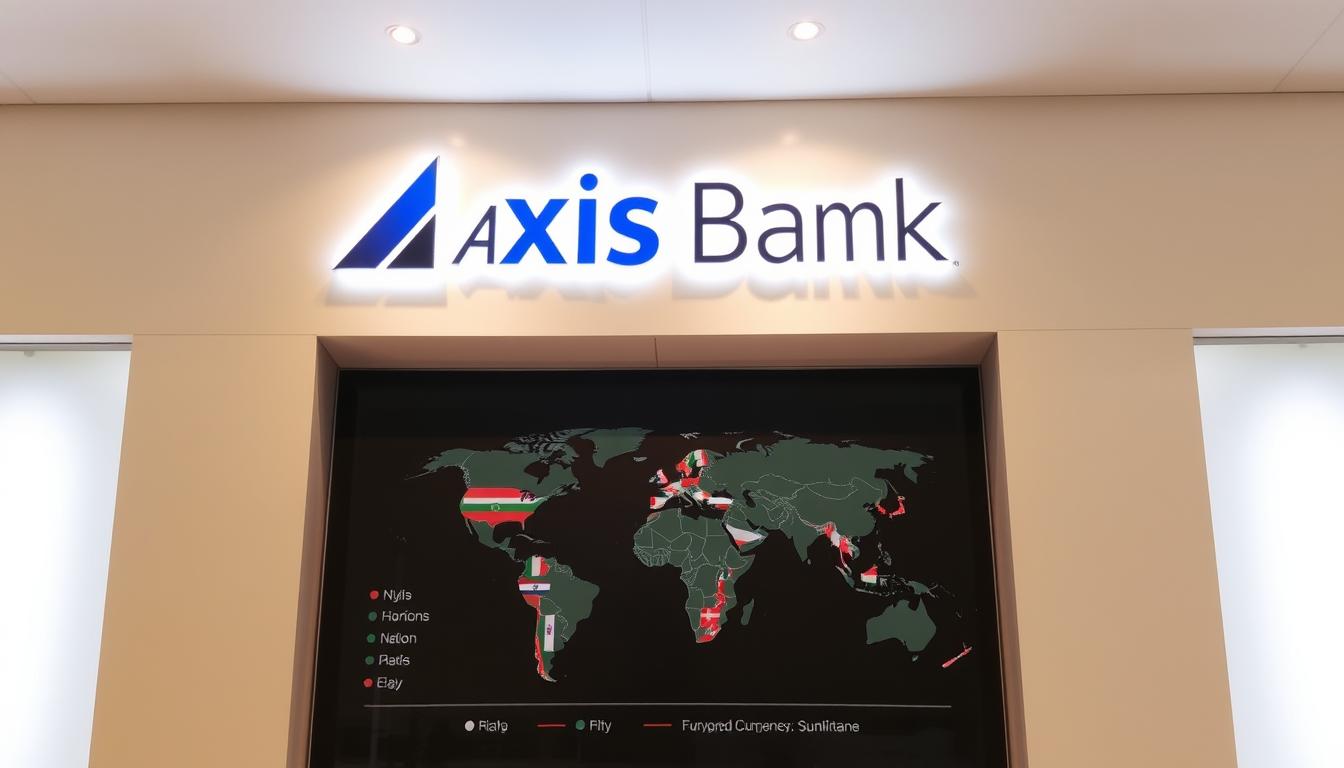Did you know that over $100 billion flows into India annually through cross-border transactions? Understanding the nuances of these transfers is crucial for seamless financial operations. This guide dives into the essentials of multi-currency transactions, focusing on Axis Bank’s offerings.
Axis Bank stands out as a leading processor of international transfers in India. Its robust infrastructure ensures compliance with FEMA regulations, making it a trusted choice for businesses and individuals alike. Knowing which currencies are supported can save time and reduce costs.
One of the bank’s standout features is its FCNR deposits, which allow customers to hold funds in multiple currencies. Combined with competitive forex rates, this makes Axis Bank a preferred option for global transactions. Stay tuned to explore how these services can benefit your financial needs.
Key Takeaways
- Axis Bank is a top choice for processing international transfers in India.
- Understanding supported currencies ensures efficient cross-border transactions.
- FCNR deposits allow holding funds in multiple currencies.
- Competitive forex rates make Axis Bank a cost-effective option.
- FEMA compliance ensures secure and legal transactions.
Introduction to Inward Remittance
India’s $100B+ remittance market highlights the importance of efficient cross-border transactions. Inward remittance refers to the process of receiving funds from abroad into a local account. This is often facilitated by NRIs, businesses, or foreign entities, making it a cornerstone of India’s financial ecosystem.
Under the RBI’s FEMA 1999 guidelines, foreign inward remittance is regulated to ensure transparency and compliance. Common use cases include NRI family support, freelance payments, and export settlements. These transactions are integral to India’s economic growth and stability.
Key components of the process include the SWIFT network, purpose codes, and FIRA documentation. The SWIFT network ensures secure and timely transfers, while purpose codes clarify the reason for the transaction. FIRA documentation acts as proof of the receiving inward remittance, ensuring legal compliance.
“India’s remittance economy is a testament to its global connectivity and financial resilience.”
Current market trends show a steady rise in cross-border money transfers, driven by India’s growing diaspora and global trade. Financial institutions like Axis Bank play a pivotal role, facilitating 18% of India’s private sector remittances. Their expertise ensures seamless and cost-effective transactions for individuals and businesses alike.
What is Inward Remittance?
Understanding the mechanics of international money transfers can save time and resources. Inward remittance refers to the process of receiving funds from abroad into a local account. This involves foreign currency conversion, often facilitated by authorized dealers like Axis Bank.
The transaction lifecycle begins with the sender initiating the transfer. The funds are then routed through the SWIFT network, ensuring secure and timely delivery. Upon arrival, the receiving bank converts the foreign currency into the local currency, completing the settlement process.
Personal and business remittance workflows differ slightly. Personal transfers are often for family support or education, while business transactions include payments for services or export settlements. Both require adherence to regulatory frameworks like RBI’s LRS limits and FEMA reporting requirements.
For example, receiving $5,000 from a US client via SWIFT involves verifying the purpose code and submitting FIRA documentation. Axis Bank’s proprietary tracking system ensures real-time updates, making the process transparent and efficient.
“Efficient handling of international funds requires knowledge of the transaction lifecycle.”
By understanding these steps, individuals and businesses can ensure smooth and compliant foreign inward remittance processes. Axis Bank’s expertise and advanced systems further enhance the experience, making it a reliable choice for global transactions.
Supported Foreign Currencies for Inward Remittance in Axis Bank
Managing international transactions becomes easier when you know the right tools and options. Axis Bank facilitates seamless cross-border payments by accepting over 15 monetary units. This flexibility ensures that individuals and businesses can operate globally without unnecessary hurdles.
The bank supports major units like USD, EUR, GBP, AUD, CAD, SGD, and JPY. These are widely used in global trade and personal transfers, making them highly accessible. For less common options like THB and ZAR, prior arrangements can be made to ensure smooth processing.
Axis Bank’s FCNR accounts allow customers to retain funds in multiple monetary units. This feature is particularly beneficial for those who frequently deal with cross-border transactions. It eliminates the need for immediate conversion, saving time and reducing costs.
Here’s a quick overview of the approved units:
- USD (United States Dollar)
- EUR (Euro)
- GBP (British Pound Sterling)
- AUD (Australian Dollar)
- CAD (Canadian Dollar)
- SGD (Singapore Dollar)
- JPY (Japanese Yen)
Each unit has specific conversion thresholds and liquidity considerations. For instance, USD and EUR are highly liquid, ensuring quick processing. Exotic options like THB may require additional time due to lower demand.
“The ability to handle multiple monetary units is a game-changer for global transactions.”
When compared to competitors, Axis Bank offers broader coverage and better flexibility. This makes it a preferred choice for those dealing with diverse international payments. Understanding these options ensures smoother and more efficient cross-border dealings.
Process of Receiving Inward Remittance in Axis Bank
Receiving funds from abroad involves a structured process that ensures efficiency and compliance. Axis Bank has streamlined this process to make it seamless for individuals and businesses. Below, we break down the key steps involved in receiving money through international transfers.
Step 1: Initiating the Transfer
The process begins when the sender initiates the transfer from their bank account. Funds are routed through secure networks like SWIFT or NEFT/NRTGS. Axis Bank ensures that the transfer is processed within 2-48 hours post-clearance, depending on the chosen method.
Step 2: Currency Conversion
Once the funds arrive, they are converted into the local currency based on the prevailing forex rates. Axis Bank offers competitive rates, ensuring that customers get the best value for their transactions. This step is crucial for minimizing costs and maximizing efficiency.
Step 3: Receiving Funds
After currency conversion, the funds are credited to the recipient’s bank account. Axis Bank sends SMS or email alerts to notify customers of successful transactions. In case of held funds due to documentation issues, the bank provides clear guidance on resolving the matter.
- SMS/Email Alerts: Real-time notifications for successful transactions.
- Exception Handling: Clear protocols for resolving documentation issues.
- Weekend/Holiday Processing: Transfers are processed on the next working day.
- FIRA Issuance: Proof of transaction is provided with a quick turnaround time.
“Efficient processing and clear communication make Axis Bank a reliable choice for international transfers.”
By following these steps, customers can ensure a smooth and hassle-free experience when receiving money from abroad. Axis Bank’s robust systems and customer-centric approach make it a trusted partner for global transactions.
Documents Required for Inward Remittance
Proper documentation is the backbone of hassle-free cross-border fund transfers. Ensuring you have the right paperwork not only speeds up the process but also ensures compliance with regulatory requirements. This section outlines the essential documents required for receiving funds from abroad.
For all transactions, KYC (Know Your Customer) documents are mandatory. These include proof of identity and address, such as a PAN card or Aadhaar card. For transactions exceeding ₹5 lakh, additional forms like FIRA Form 15CA/15CB are necessary to declare the purpose of the transfer.
For personal remittances, a PAN card and a purpose declaration (Form A2) are typically required. These help the bank understand the nature of the transaction, whether it’s for family support, education, or medical expenses. Business remittances, on the other hand, require GSTIN, export invoices, and FIRC (Foreign Inward Remittance Certificate) to ensure compliance with trade regulations.
Axis Bank simplifies the process with its NetSecure platform, allowing customers to submit documents required digitally. This reduces paperwork and speeds up processing times. Additionally, certain transactions, such as medical or education remittances, may have compliance exceptions, making the process even smoother.
“Accurate documentation ensures legal compliance and seamless processing of international payments.”
It’s important to note that all documents must be retained for a minimum of five years. This ensures that records are available for audit or verification purposes. By keeping these guidelines in mind, individuals and businesses can ensure a smooth and compliant remittance process.
RBI Guidelines for Foreign Inward Remittance
Navigating the regulatory landscape of international transactions is essential for compliance and efficiency. The Reserve Bank of India (RBI) has established clear RBI guidelines to govern cross-border fund transfers. These rules ensure transparency, security, and adherence to legal frameworks.
One key regulation is the Money Transfer Service Scheme (MTSS), which limits transactions to $2,500 per transfer and allows up to 30 transactions annually. This ensures that smaller transfers remain accessible while maintaining oversight. Additionally, certain transactions, such as those involving lottery winnings or gambling proceeds, are strictly prohibited.
Understanding the difference between LRS (Liberalized Remittance Scheme) and non-LRS transactions is crucial. LRS allows individuals to send up to $250,000 per financial year for permissible purposes, while non-LRS transactions have different thresholds and reporting requirements.
- Prohibited Transactions: Lottery, gambling, and other illegal activities.
- LRS vs Non-LRS: LRS allows $250,000/year; non-LRS has specific caps.
- Reporting Requirements: Aggregate receipts above ₹10 lakh/year must be reported.
- Recent Updates: Trade-related remittance caps have been revised to ₹15 lakh.
- Cross-Verification: Transactions are cross-checked with the Income Tax Department.
“Compliance with RBI guidelines ensures smooth and secure cross-border transactions.”
Recent updates have also impacted trade-related remittances, with caps increased to ₹15 lakh. This change reflects the growing demand for higher transaction limits in global trade. Furthermore, all transactions are cross-verified with the Income Tax Department to ensure accuracy and legality.
By adhering to these RBI guidelines, individuals and businesses can avoid penalties and ensure seamless processing of foreign inward remittance. Proper documentation, including the correct purpose code, is essential for compliance and efficiency.
Charges and Fees Associated with Inward Remittance
Understanding the costs involved in international fund transfers is essential for financial planning. Axis Bank provides a transparent fee structure to help customers manage their transaction expenses effectively. Knowing these details can save money and avoid unexpected surprises.
Axis Bank’s fee structure includes a ₹300 branch processing charge and a 0.18% GST on currency exchange. These bank charges are standard for most international transfers. However, additional fees may apply depending on the transfer method and correspondent bank involved.
Here’s a breakdown of the key charges:
- Branch processing fee: ₹300 per transaction.
- Currency conversion GST: 0.18% of the exchanged amount.
- Correspondent bank fees: Vary based on the OUR/SHA/BEN models.
Correspondent bank fees depend on the transfer model chosen. The OUR model charges the sender, SHA splits the fees, and BEN charges the recipient. Axis Bank provides clear guidance to help customers choose the most cost-effective option.
“Transparent fee structures ensure customers can plan their international transfers with confidence.”
For frequent transfers, cost optimization strategies can significantly reduce expenses. Axis Bank offers competitive rates compared to alternatives like Karbon FX, which charges a flat 0.25% fee. Additionally, understanding TCS (Tax Collected at Source) calculations for different remittance purposes can help avoid unnecessary costs.
By staying informed about these fees and charges, customers can make smarter financial decisions and maximize the value of their international transactions.
Benefits of Using Axis Bank for Inward Remittance
Choosing the right financial institution for international transactions can make a significant difference in efficiency and cost-effectiveness. Axis Bank stands out with its robust services designed to simplify cross-border payments. Its advanced features ensure seamless and secure transactions for individuals and businesses alike.
One of the key benefits is 24/7 tracking, which allows customers to monitor their transactions in real-time. This feature provides transparency and peace of mind, especially for high-value transfers. Additionally, Axis Bank supports over 150 currency corridors, making it a versatile choice for global transactions.
Here are some standout features of Axis Bank’s banking services:
- Dedicated NRI Desk: Offers regional language support to cater to the diverse needs of non-resident Indians.
- Bharat BillPay Integration: Simplifies utility payments, adding convenience to everyday financial tasks.
- Priority Routing for Senior Citizens: Ensures faster processing and personalized assistance for older customers.
- Same-Day Clearance: Available for 22 major currencies, reducing waiting times significantly.
- High Success Rate: A historical performance of 99.3% transaction success rate ensures reliability.
Axis Bank also provides FEMA advisory services to help customers navigate regulatory requirements. This ensures compliance and minimizes the risk of delays or penalties. With its customer-centric approach and advanced technology, Axis Bank remains a trusted partner for international transactions.
“Axis Bank’s comprehensive services and advanced features make it a top choice for global financial needs.”
By leveraging these benefits, customers can enjoy a seamless and cost-effective experience when managing cross-border payments. Axis Bank’s commitment to innovation and customer satisfaction sets it apart in the competitive banking landscape.
Alternative Solutions for Inward Remittance
Innovative platforms are reshaping the way businesses handle international payments. While traditional banking services remain popular, modern alternatives like Karbon FX offer competitive advantages. These solutions are designed to simplify transfers and reduce costs, making them ideal for business payments.
Karbon FX stands out with its API integration and mid-market rates, ensuring transparency and efficiency. Compared to traditional banks, it offers lower fees, especially for high-value transactions. For example, Skydo charges 0.3% for transfers above $10,000, while traditional banks may charge 0.30% plus GST.
Here’s a quick comparison of neo-banking solutions:
- Fees: Karbon FX offers lower transaction costs compared to traditional banks.
- Speed: Most platforms provide same-day or next-day processing.
- Limits: Neo-banks often have higher transaction limits, ideal for large business payments.
Hybrid models, combining traditional banking with fintech partners, are gaining traction. This approach leverages the strengths of both systems, ensuring compliance and cost efficiency. For instance, businesses can use Axis Bank for regulatory adherence while partnering with Karbon FX for competitive rates.
“Choosing the right platform can save businesses significant time and money in global transactions.”
Compliance is a critical factor when selecting alternative platforms. Ensure the provider adheres to RBI guidelines and offers robust documentation support. A case study highlights an export SME saving ₹2.8 lakh annually by switching to Karbon FX, showcasing the tangible benefits of modern solutions.
By exploring these alternatives, businesses can optimize their international payment processes, ensuring efficiency and cost-effectiveness.
Tips for Smooth Inward Remittance Transactions
Efficiently managing cross-border payments requires strategic planning and the right tools. By following a few practical tips, individuals and businesses can ensure seamless and cost-effective transactions. One key strategy is the pre-notification process, which reduces clearance time by 40%.
Timing is crucial when initiating transfers. Avoid holiday backlogs by scheduling payments during non-peak periods. This ensures faster processing and minimizes delays. For frequent receipts, maintaining USD nostro accounts can streamline the process and reduce conversion costs.
Negotiating corporate forex rates is another effective strategy. For volumes exceeding $25,000 per month, businesses can secure competitive rates, saving significant money over time. Additionally, leveraging mobile tracking tools like RemitX provides real-time updates, enhancing transparency and control.
In case of failed transactions, having clear dispute resolution protocols is essential. This ensures quick resolution and minimizes disruptions. For individuals sending family support, these measures provide peace of mind and reliability.
“Strategic planning and the right tools are the cornerstones of efficient cross-border payments.”
By adopting these practices, customers can optimize their international payment processes, ensuring efficiency and cost-effectiveness. Whether for personal or business needs, these tips make global transactions smoother and more reliable.
Conclusion
Global financial transactions are evolving rapidly, with new technologies and regulations shaping the future. Axis Bank continues to lead with its robust currency support, ensuring seamless cross-border payments for individuals and businesses alike. Emerging trends, such as blockchain-based pilots, are set to revolutionize the remittance landscape, offering faster and more secure transactions.
A cost-benefit analysis reveals that different user profiles can maximize value by leveraging the bank’s competitive rates and advanced services. For instance, frequent users benefit from lower fees, while businesses gain from streamlined processes. Looking ahead, the 2026 FEMA amendments are expected to further enhance regulatory frameworks, making transactions even more efficient.
In summary, Axis Bank’s expertise and innovative solutions make it a trusted partner for global financial needs. To explore how these services can benefit you, schedule a free forex advisory session today.







